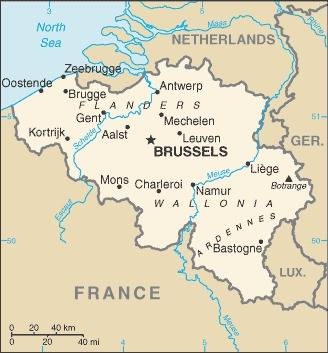58 Belgium

Three equal vertical bands of black (hoist side), yellow, and red; the vertical design was based on the flag of France. The colors are those of the arms of the duchy of Brabant (yellow lion with red claws and tongue on a black field).
Flag courtesy of the CIA World Factbook

Map courtesy of the CIA World Factbook

Our Lady of the Sablon Church in Brussels was built in the 15th century in a late Gothic style known as Brabantine. It is renowned for its brightly colored stained-glass windows.
Photo courtesy of the CIA World Factbook
Government
According to Britannica, Belgium is a constitutional monarchy. The Belgian constitution was first promulgated in 1831 and has been revised a number of times since then. A 1991 constitutional amendment, for instance, allows for the accession of a woman to the throne. Under the terms of the Belgian constitution, national executive power is vested in the monarch and his Council of Ministers, whereas legislative power is shared by the monarch, a bicameral parliament comprising the Chamber of Representatives and the Senate, and the community and regional councils. In practice, the monarch’s role as head of state is limited to representative and official functions; royal acts must be countersigned by a minister, who in turn becomes responsible for them to the parliament. The prime minister is the effective head of government; the position of prime minister was created in 1919 and that of vice prime minister in 1961. Typically the leader of the majority party or coalition in the parliament, the prime minister is appointed by the monarch and approved by the parliament.
Prior to 1970 Belgium was a unitary state. An unwritten rule prevailed that, except for the prime minister, the government had to include as many Flemish- as French-speaking ministers. Tensions that had been building throughout the 20th century between the two ethnolinguistic groups led to major administrative restructuring during the 1970s, ’80s, and ’90s. A series of constitutional reforms dismantled the unitary state, culminating in the St. Michael’s Agreement (September 1992), which laid the groundwork for the establishment of the federal state (approved by the parliament in July 1993 and enshrined in a new, coordinated constitution in 1994). National authorities now share power with executive and legislative bodies representing the major politically defined regions (Flemish: gewesten; French: régions) of Belgium, the Flemish Region (Flanders), the Walloon Region (Wallonia), and the Brussels-Capital Region, and the major language communities of the country (Flemish, French, and German). The Flemish Region, comprising the provinces of Antwerp, Limburg, East Flanders, West Flanders, and Flemish Brabant, and the Flemish Community are represented by a single council; the Walloon Region, comprising the provinces of Hainaut, Namur, Liège, Luxembourg, and Walloon Brabant, and the French Community each have a council, as do the Brussels-Capital Region and the German Community. The regional authorities have primary responsibility for the environment, energy, agriculture, transportation, and public works.
They share responsibility for economic matters, labour, and foreign trade with the national government, which also retains responsibility for defense, foreign policy, and justice. The community councils have authority over cultural matters, including the use of language and education.
Farther down the administrative hierarchy are the provinces (Flemish: provincies), each of which is divided into arrondissements and further subdivided into communes (gemeenten). The provinces are under the authority of a governor, with legislative power exercised by the provincial council. The Permanent Deputation, elected from the members of the provincial council, provides for daily provincial administration. Each commune is headed by a burgomaster, and the communal council elects the deputy mayors.
Judges are appointed for life by the monarch; they cannot be removed except by judicial sentence. At the cantonal, or lowest, judicial level, justices of the peace decide civil and commercial cases, and police tribunals decide criminal cases. At the district level, judicial powers are divided among the tribunals of first instance, which are subdivided into civil, criminal, and juvenile courts and commercial and labour tribunals. At the appeals level, the courts of appeal include civil, criminal, and juvenile divisions that are supplemented by labour courts. Courts of assizes sit in each province to judge crimes and political and press offenses. These are composed of 3 judges and 12 citizens chosen by lot.
The Supreme Court of Justice is composed of three chambers: civil and commercial, criminal, and one for matters of social and fiscal law and the armed forces. The last court does not deal with cases in depth but regulates the application of the law throughout all jurisdictions. The military jurisdictions judge all cases concerning offenders responsible to the army and, in time of war, those concerning persons accused of treason. The State Council arbitrates in disputed administrative matters and gives advice on all bills and decrees. The Arbitration Court, established in 1984, deals with disputes that develop between and among national, regional, and community executive or legislative authorities.
Belgium Civil Aviation Authority
The mission of the Belgium Civil Aviation Authority is to prepare, implement and support mobility and transport policy in consultation with our partners at regional, federal and international level. To this end, they seek a fair balance between economic development, security, the environment, social interests and the integration of the different modes of transport.
Airspace
SkyVector – Google Maps – ADS-B Exchange
ICAO countries publish an Aeronautical Information Publication (AIP). This document is divided into three parts: General (GEN), En Route (ENR) and Aerodromes (AD). ENR 1.4 details the types of airspace classes they chose to adopt from classes A through G.
Drone Regulations
Start2Drone – advice to prepare your flights safely
Register for free as an operator via the Drone Portal of DG Air Transport
Advanced Air Mobility (AAM) Regulations & Policies
Bilateral agreements facilitate the reciprocal airworthiness certification of civil aeronautical products imported/exported between two signatory countries. A Bilateral Airworthiness Agreement (BAA) or Bilateral Aviation Safety Agreement (BASA) with Implementation Procedures for Airworthiness (IPA) provides for airworthiness technical cooperation between the FAA and its counterpart civil aviation authorities.
Reciprocal acceptance of aviation safety-related approvals and services with the European Union Aviation Safety Agency (EASA) and Member States of the European Union are primarily governed by the U.S. – European Union Safety Agreement.
Advanced Air Mobility (AAM) News
2025
Video courtesy of Advanced Air Mobility Institute from the July 2025 Global AAM Forum.
2025 – Unifly, Skyports Drone Services conduct cross-border drone trial
2025
Video courtesy of Advanced Air Mobility Institute from the January 2025 Global AAM Forum. Complete session for Day 1 of this Forum is available on the Advanced Air Mobility Institute YouTube Channel
2024 – Unifly’s UTM Platform Advances Urban Air Mobility in Europe
2023 – Brussels Airport plans DronePort share acquisition
2021 – Antwerp Port to launch UTM system – appoints Unifly as industrial partner
Short Essay Questions
Scenario-Based Question
You have been hired by a Drone Startup Company. Your boss has immediately assigned this job to you.
They need you to prepare a one-page memo detailing the legalities of using a drone over Brussels, pictured above.
They need you to mention any national laws and local ordinances.
They specifically want to know what airspace (insert pictures) you will be operating in and whether or not you need an airspace authorization.
Does it matter whether or not you are a citizen of the country?
Lastly, there is a bonus for you if, as you scroll through this chapter, you find any typos or broken links!
Short Essay Questions
- What are the drone categories?
- How is registration addressed?
- How is remote ID addressed?
- What are the model aircraft rules?
- What are the commercial drone rules?
- Are there waivers or exemptions to the rules? If so, for what?
- Would you share a link to an interactive airspace map?
- How is BVLOS addressed?
- How can you fly drones at night?
- How can you fly drones over people?
- Where do you find drone NOTAMs?
- What are the rules for drone maintenance?
- What are the rules for an SMS program?
- What are some unique rules not mentioned above?
- What are the C-UAS rules?
- What are the AAM rules?

